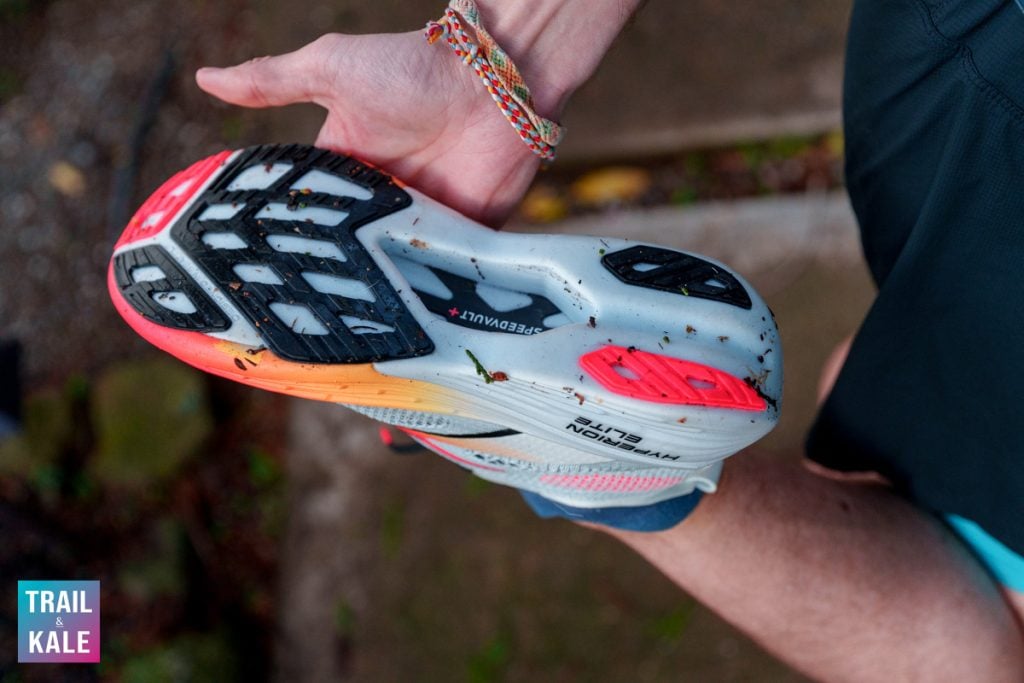One of the greatest waves of innovation in the running shoe industry over the last couple of years is undoubtedly the developments in the ‘super shoe‘ space; that is, those cutting-edge shoes that are engineered for the ultimate in speed and race day performance.
A leading player in this space is California-based ARRIS Composites – the company responsible for the innovative technology behind the carbon plate in Brooks latest super shoe, the Hyperion Elite 4.
The ARRIS plate used in the Hyperion Elite 4 isn’t just any carbon fiber plate, it’s a unique composite that offers significant benefits over more traditional carbon plates commonly used in high-end running shoes.

How carbon fiber plates in running shoes work
We’ve all heard of carbon-fiber plate running shoes, but how do they actually work?
In essence, carbon-fiber plated running shoes combine innovative materials and biomechanical engineering to enhance running performance by storin up energy and releasing it during your stride – they’re basically designed to improve performance by making running more efficient, in four key areas:
- Energy Return: The carbon-fiber plate provides superior energy return, propelling you forward by storing anf returning energy from each step, minimizing muscle exertion
- Propulsion: The plate acts like a spring, flexing under pressure and snapping back to boost your stride, aiding in speed with less effort
- Stability: Adding structure, the plate evenly distributes impact, enhances foot motion, and reduces injury risk, ensuring a stable and efficient run
- Reduced Fatigue: Enhanced propulsion and energy efficiency help lessen muscle fatigue, keeping runners feeling energized over longer distances.
How the ARRIS carbon-fiber plate enhances running performance
Let’s take a look at how the Brooks x ARRIS collaborative plate has innovated beyond the traditional carbon fiber running shoe plate producing one of the best Brooks running shoes we’ve reviewed yet.
From a running performance perspective, what makes these ARRIS plates, such as the one found in the Brooks Hyperion Elite 4, such a game-changer, is that the carbon fiber only needs to be placed where it’s needed to maximise energy return while keeping overall weight as low as possible.
For more insight into the performance of these Brooks race day super shoes, read our Hyperion Elite 4 review or watch our video.
ARRIS is the only company in the world that can blend different fibers in the same plate, for a more customized design and the ability of brands’ running shoe designers to create areas of tunable stiffness/strength, which it does by using a technology called additive molding.
- LEARN: Additive molding builds objects layer by layer, allowing for precise customization of materials like carbon fiber. Essentially, additive molding means better, personalized running shoes that can help us run more efficiently and comfortably.
This also means the whole plate doesn’t need to be made from carbon fiber, which has a couple of advantages:
- The plate’s stiffness and strength can be fine-tuned and the design can be customized to the particular model of shoe (or individual runner, even) – which you can’t do with more traditional carbon fiber plates
- Less material is needed to create the plate, which makes it lighter than a full carbon fiber plate.
So, ultimately, this should enable overall better results for athletes through improved energy return, which translates to greater running efficiency and speed.

In case this had you wondering, a development shoe for running that includes ARRIS’s carbon fiber plates was approved by World Athletics in 2022. This is huge, because not all new shoe innovations pass this essential milestone and can actually be worn for racing.
Additive molding tech vs traditional carbon fiber plates
As well as the running performance benefits of running shoe brands including the ARRIS plate in their race day super shoes, it’s also worth noting that the technology used to create them also requires less energy. This generates significantly less waste (ARRIS informed me that it’s a near-zero-waste manufacturing process), and utilizes recyclable thermoplastics.

With all that, I’m sure you’re going to see an increasing number of shoe manufacturers adopting this tech as they continue to redesign and innovate new running shoes in the months and years to come!
Other innovative running shoe technologies to enhance performance
The ARRIS plate is one of several groundbreaking technologies being used in the running shoe industry to drive innovation in speed and push the boundaries of human potential. Other technologies to watch include:
- PEBA midsoles, including PEBAX plates and derived innovations such as Nike’s ZoomX foam, which is made from PEBAX (which is a specific brand of PEBA material)
- Increasing use of cutouts, which can provide weight reduction and flexibility benefits in the midsole and outsole
- Winged carbon fiber plates, which help improve stability and may enhance propulsion.
We’ll be keeping a close eye on developments and sharing our take on new innovations and brand launches, as they’re announced – watch this space!

